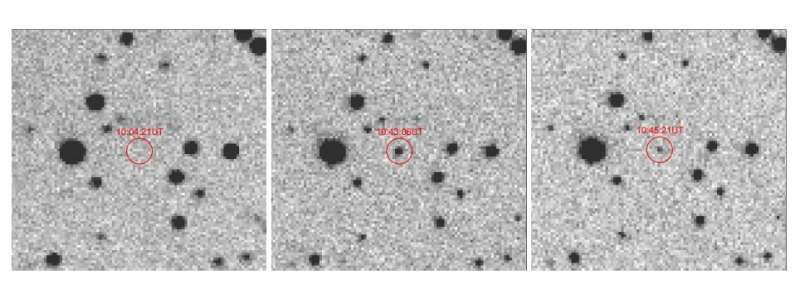January 5, 2021 report
Superflare detected on an ultracool star

Tomasz Nowakowski
astronomy writer

Using Xinglong observatory's Ground-based Wide Angle Cameras (GWAC), astronomers from China and France have detected a new superflare of an ultracool star known as SDSS J013333.08+003223.7. The newly found event, designated GWAC 181229A, appears to be one of the most powerful flares on ultracool stars so far discovered. The finding is reported in a paper published December 28 on arXiv.org.
Ultracool dwarfs (UCDs) are stellar or sub-stellar objects of spectral class M with effective temperatures below 2,700 K and masses not exceeding 0.3 solar masses. In general, they have weak chromospheric emission and are dim in X-rays, however, they sometimes exhibit flaring activity in various wavelengths.
Detecting new flares of UCDs and studying them in detail is essential to better understand the origin of these events and the interaction between the magnetic fields and surfaces of ultracool stars. One of the instruments that could be helpful in detecting new flares on UCDs is GWAC. It is one of the main ground facilities of the planned Space Variable Objects Monitor (SVOM) satellite—a joint China-France satellite mission dedicated to the detection and study of gamma-ray bursts (GRBs).
Now, a team of astronomers led by Li-Ping Xin of National Astronomical Observatories of the Chinese Academy of Sciences (CAS), reports the discovery of a powerful flare on SDSS J013333.08+003223.7—a UCD of spectral type M9, located some 471 light years away. GWAC 181229A turns out to be more powerful than typical flares usually detected on UCDs.
"In this paper, we report the detection and follow-ups of a super stellar flare GWAC181229A with an amplitude of ∆R ∼9.5 mag on a M9 type star by SVOM/GWAC and the dedicated follow-up telescopes," the astronomers wrote.
According to the study, the superflare had a bolometric energy between 55.6 and 92.5 decillion ergs, which makes it one of the most powerful flares on ultracool stars. Its magnetic strength was estimated to be at a level of 3.6-4.7 kG. The total duration of the flare from the onset to the quiescent flux level was calculated to be about 14,465 seconds.
The observations show that the superflare of GWAC181229A promptly rises from the quiescent flux level to the peak time in about 50 seconds, and then returns to a decay. The researchers found that the blackbody temperature of this star is about 5,340 K, suggesting filling factors of the flare of around 30 and 19 percent at the peak time and at 54 minutes after the first detection, respectively.
In concluding remarks, the researchers emphasized the importance of GWAC when it comes to identifying new flaring activity on ultracool stellar objects.
"Thanks to the large field of view and the high survey cadence, GWAC is well-suited for the detection of white-light flares. Actually, we have hitherto detected more than ∼ 130 white-light flares with an amplitude more than 0.8 mag. More GWAC units are planned to work in the next two years, aiming to increase the detection rate of high-amplitude stellar flares by monitoring more than 5,000 square degrees simultaneously," the authors of the paper noted.
Written for you by our author —this article is the result of careful human work. We rely on readers like you to keep independent science journalism alive. If this reporting matters to you, please consider a (especially monthly). You'll get an ad-free account as a thank-you.
More information: A ∆R ∼ 9.5 mag Super Flare of An Ultracool Star Detected by SVOM/GWAC System, arXiv:2012.14126 [astro-ph.SR]
© 2021 Science X Network




















